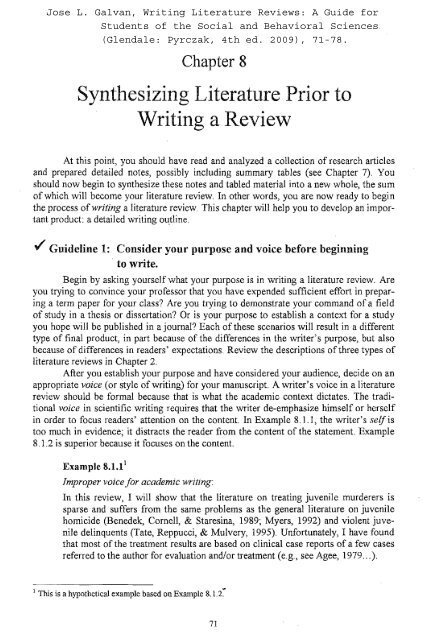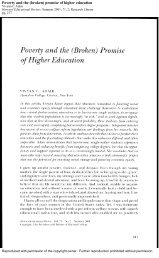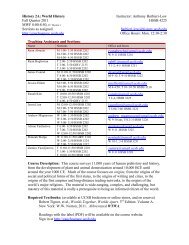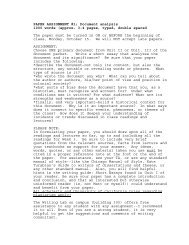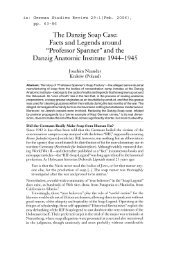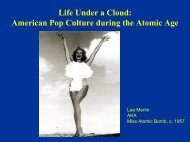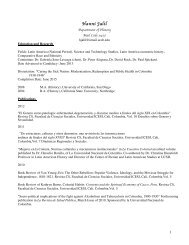Synthesizing Literature Prior to Writing a Review - UCSB ...
Synthesizing Literature Prior to Writing a Review - UCSB ...
Synthesizing Literature Prior to Writing a Review - UCSB ...
Create successful ePaper yourself
Turn your PDF publications into a flip-book with our unique Google optimized e-Paper software.
Chapter 8 <strong>Synthesizing</strong> <strong>Literature</strong> <strong>Prior</strong> <strong>to</strong> <strong>Writing</strong> a <strong>Review</strong><br />
Example 8.1.2 2<br />
Suitable voice jor academic writing:<br />
The literature on treating juvenile murderers is sparse and suffers from the same<br />
problems as the general literature on juvenile homicide (Benedek, Cornell, &<br />
Staresina, 1989; Myers, 1992) and violent juvenile delinquents (Tate, Reppucci,<br />
& Mulvery, 1995). Most of the treatment results are based on clinical case reports<br />
of a few cases referred <strong>to</strong> the author for evaluation and/or treatment (e.g., see<br />
Agee) 1979 ... ).<br />
Notice that academic writers tend <strong>to</strong> avoid using the first person. Instead, they let<br />
the material, including statistics and theories~ speak for itself. This is not <strong>to</strong> say that the<br />
first person should never be used. However, it is traditional <strong>to</strong> use it exceedingly sparingly<br />
.<br />
../ Guideline 2: Consider how <strong>to</strong> reassemble your notes.<br />
Now that you have established the purpose for writing your review, identified<br />
your audience, and established your voice, you should reevaluate your notes <strong>to</strong> determine<br />
how the pieces you have described will be reassembled. At the outset, you should recognize<br />
that it is almost always unacceptable in writing a literature review <strong>to</strong> present only a<br />
series of annotations of research studies. In essence, that would be like describing trees<br />
when you really should be describing a forest. In a literature review, you are creating a<br />
unique new forest, which you will build by using the trees you found in the literature you<br />
have read. In order <strong>to</strong> build this new whole, you should consider how the pieces relate <strong>to</strong><br />
one another while preparing a <strong>to</strong>pic outline, which is described in more detail in the next<br />
guideline.<br />
,j' Guideline 3: Create a <strong>to</strong>pic outline that traces your argument.<br />
Like any other kind of essay, the review should first establish for the reader the<br />
line of argumentation you will follow (this is called the thesis). This can be stated in the<br />
form of an assertion~ a contention, or a proposition; then, you should develop a traceable<br />
narrative that demonstrates that the line of argumentation is worthwhile and justified.<br />
This means that you should have formed judgments about the <strong>to</strong>pic based on the analysis<br />
and synthesi s of the literature you are reviewing.<br />
The <strong>to</strong>pic outline should be designed as a road map of the argument, which is illustrated<br />
in Example 8.3.1. :N otice that it starts \vith an assertion (that there is a severe<br />
shortage of donor organs, which will be substantiated with statistics, and that the review<br />
will be delimited <strong>to</strong> the psychological components of the decision <strong>to</strong> donate). This introduction<br />
is followed by a systematic review of the relevant areas of the research literature<br />
(points II and III in the outline), followed by a discussion of methodological issues in the<br />
relevant research (point IV). It ends with a summary, implications, and a discussion of<br />
2 Heide) K. M., & Solomon, E. P. (2003). Treating <strong>to</strong>dafs juvenile homicide offenders. Youth Violence and<br />
Juvenile Justice, 1> 5-31. "",<br />
72
Chapter 8 <strong>Synthesizing</strong> <strong>Literature</strong> <strong>Prior</strong> <strong>to</strong> <strong>Writing</strong> a <strong>Review</strong><br />
suggestions for future research and conclusions that refer back <strong>to</strong> the introduction (point<br />
I).<br />
Note that the authors of Example 8.3.1 have chosen <strong>to</strong> discuss weaknesses in research<br />
methodology in a separate section (point IV in the outline). Using a separate section<br />
for such a discussion is especially appropriate when all or many of the studies suffer<br />
from the same weaknesses. If different studies have different weaknesses, it is usually<br />
best <strong>to</strong> refer <strong>to</strong> the weaknesses when each study is cited (as opposed <strong>to</strong> discussing them in<br />
a separate section. of the literature review).<br />
Because the following outline will be referred <strong>to</strong> at various points throughout the<br />
rest of this chapter, please take a moment <strong>to</strong> examine it carefully. Place a flag on this<br />
page or bookmark it for easy reference <strong>to</strong> the outline when you are referred <strong>to</strong> it later.<br />
Example 8.3.1 3<br />
Sample <strong>to</strong>pic outline:<br />
Topic: Psychological Aspects of Organ Donation: Individual and Next-of-Kin<br />
Donation Decisions<br />
I. Introduction<br />
A. Establish importance of the <strong>to</strong>pic (cite statistics on scarcity of organs).<br />
B. Delimit the review <strong>to</strong> psychological components of decisions. '<br />
C. Describe organization of the paper, indicating that the remaining <strong>to</strong>pics in the<br />
outline will be discussed.<br />
II. Individual decisions regarding posthumous organ donation<br />
A. Beliefs about organ donation.<br />
B. Attitudes <strong>to</strong>ward donating.<br />
C. Stated willingness <strong>to</strong> donate.<br />
D. Summary of research on individual decisions.<br />
III. Next-of-kin consent decisions<br />
A. Beliefs about donating others' organs.<br />
B. Attitudes <strong>to</strong>ward next-of-kin donations.<br />
C. Summary of research on next-of-kin consent decisions.<br />
IV. Methodological issues and directions for future research<br />
A. Improvement in attitude measures and measurement strategy.<br />
B. Greater differentiation by type of donation.<br />
C. Stronger theoretical emphasis.<br />
D. Greater interdisciplinary focus.<br />
V. Summary, Implications, and Discussion<br />
A. Summary of points I-IV.<br />
B. Need well-developed theoretical models of attitudes and decision making.<br />
C. Current survey data lirrtited in scope and application points <strong>to</strong> the need for more<br />
sophisticated research in the future.<br />
D. Need more use of sophisticated data-analysis techniques.<br />
E. Conclusions: Psychology can draw from various sUbdisciplines for an<br />
understartding of donation decisions so that intervention strategies can be identified.<br />
Desperately need <strong>to</strong> increase the supply of donor organs.<br />
3 The outline is based on the work of Radicki, C. M., & Jaccard, 1. (1997). Psychological aspects of organ<br />
donation: A critical review and synthesis of individual and next~of-kin donation decisions. Health Psychology,16,<br />
183-195. ~<br />
73
Chapter 8 <strong>Synthesizing</strong> <strong>Literature</strong> <strong>Prior</strong> <strong>to</strong> <strong>Writing</strong> a <strong>Review</strong><br />
,/ Guideline 4: Reorganize your notes according <strong>to</strong> the path of your<br />
argument.<br />
The <strong>to</strong>pic outline described in the previous guideline describes the path of the authors'<br />
argument The next step is <strong>to</strong> reorganize the notes according <strong>to</strong> the outline. Begin<br />
by coding the notes with references <strong>to</strong> the appropriate places in the outline. For example,<br />
on the actual note cards, write a "I." beside notations that cite statistics on the scarcity of<br />
donated organs, a "II." beside notations that deal with individual decisions about organ<br />
,donations, a "III" beside notations that deal with next-of-kin decisions, and a "IV" beside<br />
notations that pertain <strong>to</strong> methodological issues. Then, return <strong>to</strong> the <strong>to</strong>pic outline and indicate<br />
the specific references <strong>to</strong> particular studies. For example, if Doe and Smith (2005)<br />
cite statistics on the scarcity of donated organs, write their names on the outline <strong>to</strong> the<br />
right of Topic 1.<br />
.J' Guideline 5: Within each <strong>to</strong>pic heading, note differences among<br />
studies.<br />
The next step is <strong>to</strong> note on your <strong>to</strong>pic outline the differences in content among<br />
studies. Based on any differences, you may want <strong>to</strong> consider whether it is possible <strong>to</strong><br />
group the articles in<strong>to</strong> sub<strong>to</strong>pics. For instance~ for "Beliefs about organ donation" (point<br />
II.A. in Example 8.3.1)~ the literature can be grouped in<strong>to</strong> the five subcategories shown in<br />
Example 8.5.1.<br />
Example 8.5.1<br />
Additional sub<strong>to</strong>pics jor point Il.A. in Example 8.3.1:<br />
1. Religious beliefs<br />
2. Cultural beliefs<br />
3. Knowledge (Le., beliefs based on "facts" people have gathered from a variety<br />
of sources)<br />
4. Altruistic beliefs<br />
5. Normative beliefs (i.e.) beliefs based on perceptions of what is acceptable<br />
within a particular social group)<br />
These would become sub<strong>to</strong>pics under point II.A. ("Beliefs about organ donation") in the<br />
<strong>to</strong>pic outline. In other words, your outline will become more detailed as you identify additional<br />
SUb<strong>to</strong>pics.<br />
"1"'1. __ 4.1. __ .... ~._~ _r,l;.C'r~ ____ ~ _.~ •• __ .!11 __ .~_+ +~ ~~~M~,l~_: ..... 1.-. ............ ,... .... : .... +"" ..... ,.. .... ""+' .... ,.." .. 1+ ...<br />
.tllti Ulliel Lyt'ti U1 Ull1tilC;U\.IC; yuu WIll Wa,lll.. LV \.IVl1~.lUC;l Ii:) Ulv vUl1i:)U~I,C;Uvy UJ. l,-,i::IU!Li::I<br />
from study <strong>to</strong> study. For instance, the reviewers on whose work Example 8.3.1 is based<br />
found three articles suggesting that there are cultural obstacles that reduce the number of<br />
organ donations among 'Hispanics, while one other article indicated a willingness <strong>to</strong> donate<br />
and a high level of awareness about transplantation issues among this group. When<br />
you discuss such discrepancies, assist your reader by providing relevant information<br />
about the research, with an eye <strong>to</strong> identifying possible explanations for the differences.<br />
Were the first three articles older and the last one more current? Did the first three use a<br />
different methodology for collecting the data (e.g., did those with the negative results ex-<br />
,.,.<br />
74
Chapter 8 <strong>Synthesizing</strong> <strong>Literature</strong> <strong>Prior</strong> <strong>to</strong> <strong>Writing</strong> a <strong>Review</strong><br />
amine hospital records while the one with a positive result used self-report questionnaires)?<br />
Noting differences such as these may provide you with important issues <strong>to</strong> discuss<br />
when you are writing your literature review .<br />
../ Guideline 6: Within each <strong>to</strong>pic heading, look for obvious gaps or<br />
areas needing more research ..<br />
In the full review based on the <strong>to</strong>pic outline in Example 8.3.1, the reviewers noted<br />
that whereas much cross-cultural research has been conducted on Mrican Americans,<br />
Asian Americans, and Hispanics, only a few studies have focused on Native Americans.<br />
Thus, any conclusions. may not apply <strong>to</strong> the latter group. In addition, this points <strong>to</strong> an area<br />
that might be recommended for consideration in the planning of future research .<br />
../ Guideline 7: Plan <strong>to</strong> br~ef1y describe relevant theories.<br />
The importance of theoretical literature is discussed in Chapter 1. You should<br />
plan <strong>to</strong> briefly describe each theory. Example 8.7.1 illustrates a brief description of social<br />
comparison theory. Note that the authors start with a summary of the original theory and<br />
then proceed <strong>to</strong> discuss how the theory has been modified over time. This organization<br />
helps readers <strong>to</strong> more fully understand the theory.<br />
Example 8.7.1 4<br />
Brief definition of a relevant theory:<br />
Festinger's (1954) social comparison theory asserts that (1) individuals have<br />
a drive <strong>to</strong> evaluate their opinions and abilities; (2) in the absence of objective,<br />
nonsocial criteria, individuals engage in social comparison (i.e., they compare<br />
their opinions and abilities <strong>to</strong> other individuals); and (3) whenever possible, social<br />
comparisons are made with similar others.<br />
Since its original formulation, social comparison theory has undergone a<br />
number of revisions. First, it is now acknowledged that unsought comparisons<br />
rna y occur and that the referent point used in the comparison process may be an<br />
individual dissimilar <strong>to</strong> oneself (Martin & Kennedy, 1993). Second, social comparison<br />
also may occur on dimensions such as physical appearance ....<br />
../ Guideline 8: Plan <strong>to</strong> discuss how individual studies relate <strong>to</strong> and<br />
You should consider how individual studies, which are often narrow, help <strong>to</strong> define,<br />
illustrate, or advance -theoretical notions. Often, researchers will point out how their<br />
studies relate <strong>to</strong> theory, which will help you in your considerations of this matter. In your<br />
<strong>to</strong>pic outline, specify that one or more theories will be discussed in your literature review,<br />
as was done in point V.B. in Example 8.3.1, which indicates that the reviewer will discuss<br />
the need for well-developed theoretical models.<br />
4 Morrison, T. G., Kalin, R., & Morrison, M. A. (2001,). Body-image evaluation and body-image investment<br />
among adolescents: A test of sociocultural and social comparison theories. Adolescence, 39, 571-592.<br />
75
Chapter 8 <strong>Synthesizing</strong> <strong>Literature</strong> <strong>Prior</strong> <strong>to</strong> <strong>Writing</strong> a <strong>Review</strong><br />
If there are competing theories in your area, plan <strong>to</strong> discuss the extent <strong>to</strong> which<br />
the literature you have reviewed supports each of them, keeping in mind that an inconsistency<br />
between the results of a study and a prediction based on theory may result from either<br />
imperfections in the theoretical model or imperfections in the research methodology<br />
used in the study .<br />
../ Guideline 9: Plan <strong>to</strong> summarize periodically and again near the<br />
end of the review.<br />
It is helpful <strong>to</strong> summarize the inferences, generalizations, andlor conclusions you<br />
have drawn from your review of the literature in stages. For instance, the outline in Example<br />
8.3.1 calls for summaries at two intermediate points in the literature review (i. e.,<br />
points II.D. and III.C.). Long, complex <strong>to</strong>pics within a literature review often deserve<br />
their own separate summaries. These summaries help readers <strong>to</strong> understand the direction<br />
the author is taking and invite readers <strong>to</strong> pause, think about, and internalize difficult material.<br />
You have probably already noticed that the last main <strong>to</strong>pic (Topic V.) in Example<br />
8.3.1 calls for a summary of all the material that preceded it. It is usually appropriate <strong>to</strong><br />
start the last section of a long review with a summary of the main points already covered.<br />
This shows readers what the writer views as the major points and sets the stage for a discussion<br />
of the writer's conclusions and any implications he or she has drawn. In a very<br />
short literature review, a summary may not be needed .<br />
./ Guideline 10: Plan <strong>to</strong> present conclusions and implicationso<br />
Note that a conclusion is a statement about the state of the knowledge on a <strong>to</strong>pic.<br />
Example 8.10.1 illustrates a conclusion. Note that it does not say that there is "proof"<br />
<strong>Review</strong>ers should hedge and talk about degrees of evidence (e. g.} "It seems safe <strong>to</strong> conclude<br />
that ... ," "One conclusion might be that .. ," "There is strong evidence that ... ," or<br />
"The evidence overwhelmingly supports the conclusion that ... ").<br />
Example 8.10.1<br />
In light of the research on cultural differences in attitudes <strong>to</strong>ward organ donation,<br />
it seems safe <strong>to</strong> conclude that (emphasis added) cultural groups differ substantially<br />
in their attitudes <strong>to</strong>ward organ donation and that effective intervention<br />
strateRies need <strong>to</strong> take account of these differences. Specifically ...<br />
If the weight of the evidence on a <strong>to</strong>pic does not clearly favor one conclusion over<br />
the other, be prepared <strong>to</strong> say so. Example 8.10.2 illustrates this technique.<br />
Example 8.10.2<br />
Although the majority of the studies indicate Method A is superior, several methodologically<br />
strong studies point <strong>to</strong> the superiority of Method B. In the absence of<br />
additional evidence, it is difficult <strong>to</strong> conclude that (emphasis added) ....<br />
76
Chapter 8 <strong>Synthesizing</strong> <strong>Literature</strong> <strong>Prior</strong> <strong>to</strong> <strong>Writing</strong> a <strong>Review</strong><br />
An implication is usually a statement of what individuals or organizations should<br />
do in light of existing research. In other words, a reviewer usually should make suggestions<br />
as <strong>to</strong> what actions seem promising based on the review of the research. Thus, it is<br />
usually desirable <strong>to</strong> include __ the heading "Implications" near the end of a <strong>to</strong>pic outline.<br />
Example 8.10.3 is an implication because it suggests that a particular intervention might<br />
be effectively used with a particular group.<br />
Example 8.10.3<br />
The body of evidence reviewed in this paper suggests that when working with<br />
Asian Americans, Intervention A seems most promising for increasing the number<br />
of organ donations made by this group.<br />
At first, some novice writers believe that they should describe only "facts" from<br />
the published research and not venture <strong>to</strong> offer their own conclusions and related implications.<br />
Keep in mind, however, that an individual who thoroughly and carefully reviewed<br />
the literature on a <strong>to</strong>pic has, in fact, become an expert on it. Whom else should we look <strong>to</strong><br />
for advice on the state of a knowledge base (conclusions) and what we should do <strong>to</strong> be<br />
more effective (implications) than an expert who has up-<strong>to</strong>-date knowledge of the research<br />
on a <strong>to</strong>pic? Thus, it is appropriate <strong>to</strong> express your conclusions regarding the state<br />
of knowledge on a <strong>to</strong>pic and the implications that follow from them .<br />
../ Guideline 11: Plan <strong>to</strong> suggest specific directions for future research<br />
near the end of the review.<br />
Note that in the outline in Example 8.3.1, the reviewers plan <strong>to</strong> discuss future research<br />
in point V.C. As you plan what <strong>to</strong> say, keep in mind that it is inadequate <strong>to</strong> simply<br />
suggest that "more research is needed in the future." Instead, make sp-ecific suggestions.<br />
For instance, if all (or almost all) the researchers have used self-report questionnaires,<br />
you might call for future research using other means of data collection, such as direct observation<br />
of physical behavior and an examination of records kept by agencies that coordinate<br />
donations. If there are understudied groups such as Native Americans, you might<br />
call for more research on them. If almost all the studies are quantitative, you might call<br />
for additional qualitative studies. The list of possibilities is almost endless. Your job is <strong>to</strong><br />
suggest those that you think are most promising for advancing knowledge in the area you<br />
are reVIeWing .<br />
../ GuideHne 12: Flesh out your outline with details from your analysis.<br />
The final step before you begin <strong>to</strong> write your first draft is <strong>to</strong> review the <strong>to</strong>pic outline<br />
and flesh it out with specific details from your analysis of the research literature.<br />
Make every effort, as you expand the outline, <strong>to</strong> include enough details <strong>to</strong> be able <strong>to</strong> write<br />
clearly about the studies you are including. Make sure <strong>to</strong> note the strengths and weaknesses<br />
of studies as well as the gaps, relationships, and major trends or patterns that -<br />
emerge in the literature. At the end of this step, your outline should be several pages long,<br />
and you will be ready <strong>to</strong> write your first draft.<br />
77
Chapter 8 <strong>Synthesizing</strong> <strong>Literature</strong> <strong>Prior</strong> <strong>to</strong> <strong>Writing</strong> a <strong>Review</strong><br />
Example 8.12.1 illustrates how a small portion of the <strong>to</strong>pic outline in Example<br />
8.3.1 (specifically, point II.A.I. in Example 8.12.1) would lookif it were fleshed out with<br />
additional details.<br />
Example 8.12.1<br />
Part of a fleshed-out outline:<br />
II. Individual decisions regarding posthumous organ donation<br />
A. Beliefs about organ donation (research can be categorized in<strong>to</strong> 5 major groupings)<br />
1. Religious beliefs<br />
a. Define the term "religious beliefs"<br />
b. Religions that support organ donation<br />
(1) Buddhism, Hinduism (Ulshafer, 1988; Woo, 2002)<br />
(2) Catholicism (Ulshafer, 1988)<br />
(3) Judaism (Bulka, 1990; Cohen, 1988; Pearl, 1990~ Weiss, 1988)<br />
(4) Protestantism (Walters, 1988)<br />
(5) Islam (Gatrad, 1994; Rispler-Chaim, 1989~ Sachedina, 2003)<br />
c. Religions that do not support it<br />
(1) Jehovah's Witnesses (Corlett, 2003; Pearl, 2004)<br />
(2) Orthodox Judaism (Corlett, 2003; Pearl, 2004)<br />
d. Other sources that have commented on religio~ as a barrier (Basu et al., 1989;<br />
Gallup Organization, 1993; Moore et al., 2004)<br />
Notice that several of the references in Example 8.12.1 appear in more than one<br />
place. For instance, CorletC s 2003 report will be referred <strong>to</strong> under a discussion df both<br />
Jehovah's Witnesses and Orthodox Judaism. This is appropriate because a reviewer<br />
should not be writing a series of summaries in which Corlett's study is summarized in<br />
one place and then dropped from the discussion. Instead, it should be cited as many times<br />
as needed, depending on how many specific points it bears on in the outline.<br />
Activities for Chapter 8<br />
Directions: For each of the modelliterature reviews that your instruc<strong>to</strong>r assigns, answer<br />
the following questions. The model reviews are near the end of this book<br />
1. Did the author use an appropriate academic voice? Did the author write in the first<br />
person? Explain.<br />
2. Does the author's argument move logically from one <strong>to</strong>pic <strong>to</strong> another? Explain.<br />
3. Has the author pointed out areas needing more research? Explain.<br />
78


